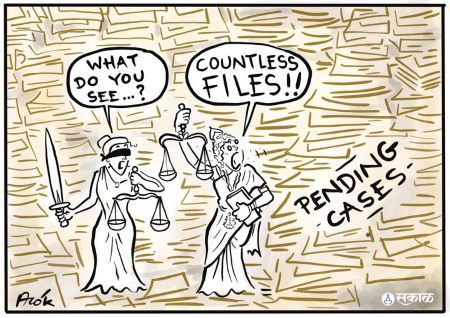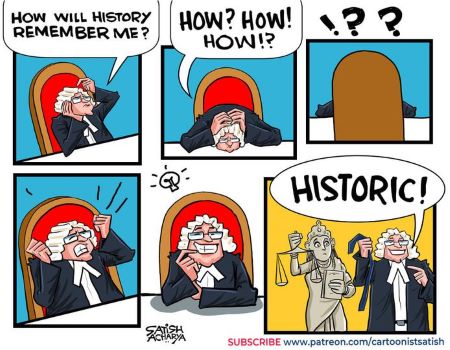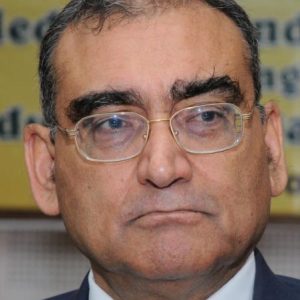This gesture raises questions about its relevance in light of the widespread poverty and socio-economic challenges facing millions of Indians.
On Thursday, 17th October, the Chief Justice of India, Justice D.Y. Chandrachud, unveiled a new statue of Lady Justice in the Supreme Court Judges Library. Departing from the traditional depiction, this Lady Justice is without a blindfold and holds a copy of the Indian Constitution in place of the customary sword.
The absence of a blindfold is meant to symbolize that law is not blind but aware and discerning. The Chief Justice highlighted that this new representation emphasizes that justice cannot be blind in a society like India, where the complexities and inequities require a nuanced approach.
But has Justice Chandrachud ever truly considered what justice is? I submit that justice is not merely the delivery of verdicts in courts of law.
 Real justice, in my view, goes far beyond legal procedures and courtroom decisions. Justice means ensuring that every Indian enjoys access to essential socio-economic rights—employment with adequate income, nutritious food, proper healthcare, quality education for their children, and dignified housing. In short, it means uplifting the people from poverty and ensuring their well-being.
Real justice, in my view, goes far beyond legal procedures and courtroom decisions. Justice means ensuring that every Indian enjoys access to essential socio-economic rights—employment with adequate income, nutritious food, proper healthcare, quality education for their children, and dignified housing. In short, it means uplifting the people from poverty and ensuring their well-being.
This holistic idea of justice was understood by former U.S. President Franklin D. Roosevelt, who, in his State of the Union Address on 11th January 1944, proposed a Second Bill of Rights for the U.S. Constitution. These rights included socio-economic guarantees, such as the right to suitable employment, adequate medical care, education, and the ability to earn a living wage.
Roosevelt believed that without these fundamental economic securities, the civil and political liberties enshrined in the U.S. Constitution were mere illusions for the impoverished masses.
Similarly, the Indian Constitution, while it contains fundamental rights in Part 3, including the right to free speech, liberty, and equality, remains disconnected from the harsh realities faced by millions of citizens.
For example, what does freedom of speech (Article 19(1)(a)), freedom of movement (Article 19(1)(d)), or the freedom to engage in business (Article 19(1)(g)) mean to an individual who is starving, unemployed, or struggling to survive? To such a person, these lofty ideals mean nothing. Freedom without the basic means to exercise it is illusory.
 With all due respect to Justice Chandrachud, the unveiling of this new statue of Lady Justice is just a shenanigan and irrelevant to the Indian people. It does nothing to address the deep-rooted and systemic issues that plague this country.
With all due respect to Justice Chandrachud, the unveiling of this new statue of Lady Justice is just a shenanigan and irrelevant to the Indian people. It does nothing to address the deep-rooted and systemic issues that plague this country.
India is grappling with massive poverty, staggering levels of unemployment, and an appalling child malnutrition crisis.
According to the Global Hunger Index (GHI) 2023, India ranked among the worst in terms of child wasting—every second child in the country is malnourished, and the situation is only deteriorating.
The country’s slipping rank on the GHI highlights the severity of the hunger and nutrition crisis, and yet, little has been done to alleviate these conditions.
Moreover, the prices of essential commodities—food, fuel, and medicine—continue to skyrocket, making survival even more difficult for the average Indian.
 Healthcare remains inaccessible to millions, good education is a distant dream for many, and the housing situation is abysmal, with millions of Indians still living in squalid conditions in slums or “jhuggi jhopdis” (shantytowns).
Healthcare remains inaccessible to millions, good education is a distant dream for many, and the housing situation is abysmal, with millions of Indians still living in squalid conditions in slums or “jhuggi jhopdis” (shantytowns).
These are the pressing issues that affect the daily lives of the masses, and justice, if it is to mean anything, must address these socio-economic realities.
To put it bluntly, while the Chief Justice’s unveiling of the statue may reflect a symbolic shift in how the judiciary views justice, it totally ignores the urgent and practical concerns of the people.
True justice lies not in symbolic gestures but in ensuring that every Indian can live with dignity, free from the chains of poverty and deprivation. Until these issues are addressed, such events remain nothing more than distractions—shenanigans, as I have termed them—from the real struggles of the Indian population. ![]()
Disclaimer : PunjabTodayNews.com and other platforms of the Punjab Today group strive to include views and opinions from across the entire spectrum, but by no means do we agree with everything we publish. Our efforts and editorial choices consistently underscore our authors’ right to the freedom of speech. However, it should be clear to all readers that individual authors are responsible for the information, ideas or opinions in their articles, and very often, these do not reflect the views of PunjabTodayNews.com or other platforms of the group. Punjab Today does not assume any responsibility or liability for the views of authors whose work appears here.
Punjab Today believes in serious, engaging, narrative journalism at a time when mainstream media houses seem to have given up on long-form writing and news television has blurred or altogether erased the lines between news and slapstick entertainment. We at Punjab Today believe that readers such as yourself appreciate cerebral journalism, and would like you to hold us against the best international industry standards. Brickbats are welcome even more than bouquets, though an occasional pat on the back is always encouraging. Good journalism can be a lifeline in these uncertain times worldwide. You can support us in myriad ways. To begin with, by spreading word about us and forwarding this reportage. Stay engaged.
— Team PT

